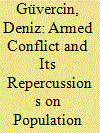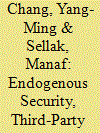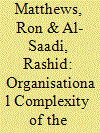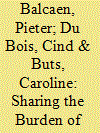|
|
|
Sort Order |
|
|
|
Items / Page
|
|
|
|
|
|
|
| Srl | Item |
| 1 |
ID:
189462


|
|
|
|
|
| Summary/Abstract |
The study empirically examines the impact of armed conflict on population growth in Eastern Turkey. The empirical findings confirm the implications of the theoretical model in the body of the paper. The results indicate that PKK recruitment leads to depopulation at the district level while increases rural population growth. Moreover, the results indicate that the number of killed PKK militants in the province to which a district belongs negatively affects population growth at the district level. On the other hand, the results also indicate that number of killed PKK militants does not significantly affect the population growth at the district level while decreases rural population growth. The results show that the percentage of valid votes to registered voters increases the population growth at the district level.
|
|
|
|
|
|
|
|
|
|
|
|
|
|
|
|
| 2 |
ID:
189460


|
|
|
|
|
| Summary/Abstract |
This study discusses a topic that is relatively understudied in economics: looting and destruction of cultural heritage sites and objects during epochs of violence. While economic literature on culture, cultural practices, and cultural institutions is long-standing, overlooked are the economic motivations for heritage (a material expression of culture) destruction, the economic consequences of the destruction, and potential policies for prevention from future destruction. Heritage objects during peace times turn into blood antiquities during violent conflicts. Illicit excavations in one country garnish museums in another. Covering a bird’s-eye view of these topics, the study also highlights prospects for future economic research and reiterates a unique opportunity cultural heritage reconstruction may provide for reconciliation in post-conflict countries.
|
|
|
|
|
|
|
|
|
|
|
|
|
|
|
|
| 3 |
ID:
189457


|
|
|
|
|
| Summary/Abstract |
This paper examines third-party trade and its implications for conflicts between hostile countries not engaging in trade. We present a conflict-theoretic model to analyze two adversaries’ endogenous arming decisions when they separately establish a free trade agreement (FTA) with a neutral third-party state. We contrast this multiple FTAs regime with a single FTA regime between one adversary and the third-party state, which excludes the other adversary as a non-member. In our analysis, the benchmark case is a protectionist regime when the bilateral trade between the third-party state and each of the adversaries is a tariff war. Among the three trade regimes, we show that the two adversaries’ aggregate arming is the lowest under multiple FTAs but is the highest under a single FTA. These results suggest that, despite no trade between two adversary countries, multiple FTAs through third-party trade have the pacifying or appeasing effect of lowering overall military buildups in interstate conflicts.
|
|
|
|
|
|
|
|
|
|
|
|
|
|
|
|
| 4 |
ID:
189458


|
|
|
|
|
| Summary/Abstract |
In an important subset of armed conflicts, there is a large disparity between the belligerents’ capabilities. Although the outcomes of such wars cannot be predicted with absolute certainty, the chances that a weak state will triumph are often so low that private information is not a satisfying explanation for conflict. Under which circumstances, then, does the disadvantaged side give in rather than attempting to fight? And what explains variation in effort levels by strong states? I present a model of an environment in which a strong state faces political pressure to replace the losing government following a costly war. I show that there is a non-monotonic relationship between the effort the winning state devotes to the war and the probability that the losing state surrenders – when war effort is low, the weaker state fights because it has a decent chance of winning; when it is high, the weak state fights because it recognizes that it will be replaced upon surrender. Further results are derived to explain the domestic political foundations of variation in strong states’ investments in lopsided conflicts. The results help rationalize a number of historical instances of lopsided conflict.
|
|
|
|
|
|
|
|
|
|
|
|
|
|
|
|
| 5 |
ID:
189461


|
|
|
|
|
| Summary/Abstract |
The European Union (EU) promotes arms collaboration as a stepping-stone towards the evolution of an integrated European defence technology and industrial base. It will necessarily comprise prime contractors and their attendant supply chains, with the latter particularly important because they represent a refined regional division of labour, promoting efficiencies through skill-based specialisation. Paradoxically, however, Europe’s largest military aerospace collaborative venture, the Eurofighter Typhoon, possesses a complex supply chain subject to political and institutional strictures, as well as potential inefficiencies. Partner nations prioritise national sovereignty objectives through duplicated assembly lines and work allocation arrangements based on juste retour (fair share) rather than market-driven competitiveness criteria. The purpose of this paper, then, is to explore Typhoon’s supply chain complexity, especially the impact of juste retour policy. The findings from this analysis will highlight important policy issues influencing the future supply chain model of Europe’s successor 6th-Generation fighter programme.
|
|
|
|
|
|
|
|
|
|
|
|
|
|
|
|
| 6 |
ID:
189459


|
|
|
|
|
| Summary/Abstract |
This paper aims to compare the educational attainment of a conflict region (the Deep South) and a non-conflict region (the rest of the South) of Thailand using the Socio-Economic Survey, 2015. This paper employs the Instrumental Variable approach and Oaxaca-Blinder decomposition in an intergenerational regression model. When controlling parental schooling, household income and size, religion, and gender, the results show that children from the Deep South obtain almost one year less schooling than children from the rest of the Southern region. Interestingly, Muslims are ahead in terms of educational attainment when compared to non-Muslims in the non-conflict region, but not in the conflict region. Females outperform males in both regions, but the coefficient of female dummy is higher in the non-conflict region. Moreover, the rate of intergenerational transmission of educational attainment is higher in the Deep South compared to that in the rest of the southern region, which may lead to long-term educational inequality in the Deep South region. The Oaxaca-Blinder decomposition confirms that the 40% schooling gap between these two regions is unexplained but might be due to the chronic social unrest. The findings of this paper show that customized educational reforms and policies to resolve the conflict in the Deep South of Thailand should be employed.
|
|
|
|
|
|
|
|
|
|
|
|
|
|
|
|
| 7 |
ID:
189456


|
|
|
|
|
| Summary/Abstract |
This article discusses the effects of the changing (hybrid) conflict environment on the burden sharing debate. We discuss the actions taken by both the alliance as the member states in repelling these threats, arguing that this mainly produces security outputs that are private or impure public. As the burden sharing literature currently lacks notions of hybrid threats, we believe the current modelling to be ill-suited to provide reliable assessments of member states’ burden sharing behaviour. We address this void by adjusting the Joint Product Model, extending a country’s security activities to a more inclusive ‘whole of government (WoG) approach’. We depart from this WoG model to stress the challenges associated with comparing the contributions of member states in countering these threats. This leads us to dispute the use of aggregate military expenditures as a main variable to measure a country’s degree of free riding. More and other types of (non-military) variables and proxy-indexes should be taken into account. The same remark goes for estimating the benefit-burden concordance within this framework of permanent non-linear state competition.
|
|
|
|
|
|
|
|
|
|
|
|
|
|
|
|
| 8 |
ID:
189455


|
|
|
|
|
| Summary/Abstract |
The legacy of the 1999 Columbine School shooting has resulted in increased political elements in subsequent shootings and the line between these school shooters and terrorists has blurred. Current research comparing terrorists and school shooters has largely focused on the similarities between the perpetrators using largely qualitative methods. With the behavioural and subsequent economic impacts of terrorism having been previously identified, this paper investigates if these behavioural changes and impacts are present following school shootings. Through the use of a logit regression of historical school shooting data, we find evidence that support our theories that school shootings cause fear and change consumer behaviours.
|
|
|
|
|
|
|
|
|
|
|
|
|
|
|
|
|
|
|
|
|